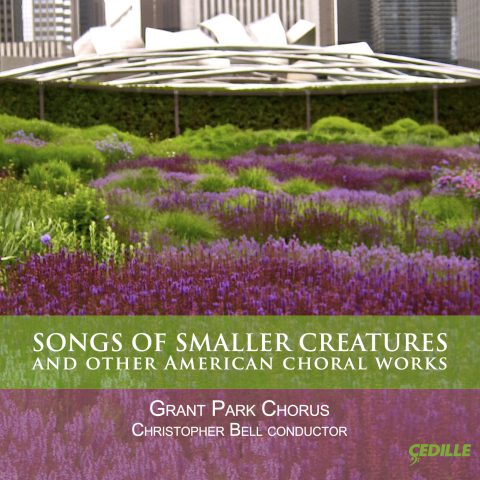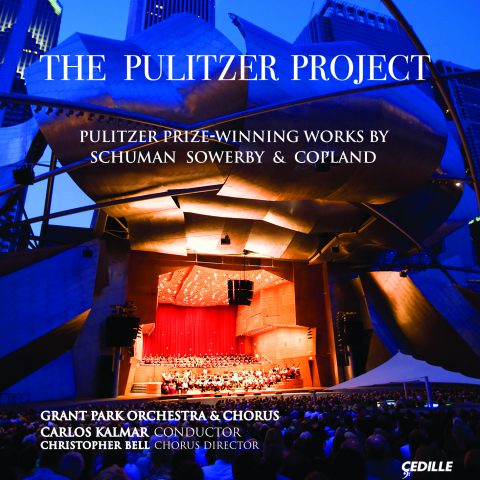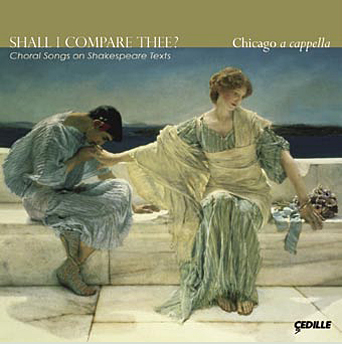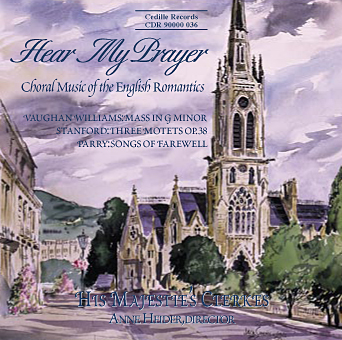| Subtotal | $12.00 |
|---|---|
| Tax | $0.92 |
| Total | $9.92 |
Store
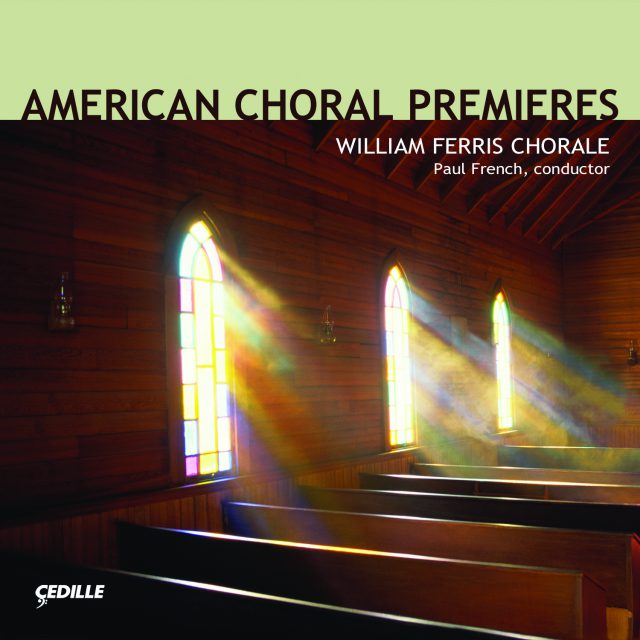
Store
American Choral Premieres
William Ferris Chorale, Paul French
Easley Blackwood, William Ferris
American Choral Premieres is the latest testament to the choir’s mission and stellar reputation.
With its music director and conductor Paul French, the mid-size, mixed-voice ensemble performs world-premiere recordings of sacred and spiritual pieces by nine recent and contemporary composers including Alan Hovhaness’s Four Motets, Op. 268; George Rochberg’s Behold, My Servant; Easley Blackwood’s A King James Magnificat, Op. 44; and William Ferris’s Lyrica Sacra.
Preview Excerpts
ALAN HOVHANESS (1911 – 2000)
Four Motets, Op. 268
EGON COHEN (b. 1984)
PAUL NICHOLSON (b. 1963)
PAUL FRENCH (b. 1959)
EASLEY BLACKWOOD (b. 1933)
ROBERT KREUTZ (1922 – 1996)
WILLIAM FERRIS (1937 – 2000)
Lyrica Sacra
WILLIAM C. WHITE (b. 1983)
GEORGE ROCHBERG (1918 – 2005)
Artists
Program Notes
Download Album BookletAmerican Choral Premieres
Notes by Andrea Lamoreaux
American Choral Premieres is a collection of sacred pieces with texts drawn from the Bible, from non-Biblical sacred writings, and from poetry; in several cases these texts are strikingly combined within one composition. The performance of sacred music of all periods and styles has long been a hallmark of Chicago’s William Ferris Chorale. Here the group has selected some texts that are quite familiar and others that are rarely set. All of the compositions receive their premiere recordings.
The prolific Alan Hovhaness (1911–2000) was often inspired by sacred or mystical themes in both his instrumental and vocal works. The Four Motets, Op. 268, composed in 1973, set texts from the Hebrew Bible: verses from the prophet Jeremiah and from three Psalms. In terms of strict musicological identification, the pieces might better be called anthems than motets, since a motet traditionally uses a Latin text, one that may or may not be from the Bible, while an anthem is usually in English (as Hovhaness’s set is) and often uses words from the Psalms. Whatever name one might use, this transparent and straightforward foursome is characterized by its use of mostly-tonal harmonies and chordal structure, strikingly contrasted at times with fugal passages, and Hovhaness’s care in expressing the meaning of the words.
The first piece, “Blessed is the Man,” is the simplest. Often a gloom-and-doom prophet, Jeremiah in this passage makes a strongly affirmative statement of belief. The music, in its homophonic opening and short fugato that follows, serves to emphasize what to Hovhaness is clearly one of the most important words: “Blessed.” The other most important word, “Lord,” is then highlighted by being stretched out with elaborate scale passages in all the voices. More complex harmonies are featured in “Help, Lord,” as the psalmist laments the sinfulness he sees around him. Once again the music focuses on the key word: “Help.” The second half of the motet is a strong, tonally harmonized statement of faith in God’s word. The third motet begins as an exultant hymn of praise, with the words “Lord” and “Holy” made to stand out. The answer to the question “Who shall abide” is offered first in fugato, and we hear the words repeated to reinforce the importance of the answer: “He that walketh uprightly.” The heart of the text is presented in sharp contrast: pianissimo, in suddenly triadic harmony, we hear, “And speaketh the truth in his heart.” Dynamic contrasts characterize this motet and its successor, which opens with the fortissimo unison statement, “The fool hath said in his heart.” This is succeeded quickly by fugal entries and chromatic accents in each part. Shifting from minor to major and back to pianissimo, Hovhaness shows us God’s response to the fool and his lack of understanding. Another set of fugal entries highlights the words “And seek God.” These final, most important words are rendered in mostly ascending motives, to symbolize aspiration.
The Chicago-based composer and teacher Easley Blackwood is represented on American Choral Premieres by a Magnificat. Egon Cohen (b. 1984), one of Blackwood’s former students at the University of Chicago, was invited to submit a piece to the Chorale for this CD project, his setting of the Stabat Mater. This Latin text dates from the 13th century; it has been put to music by a great number of composers, usually in its original language, but sometimes translated, as is Mr. Cohen’s setting. The image it presents is stark and universal: Mary, the grieving mother, standing at the foot of the cross whereon her son, Jesus, is being put to death. The poet — usually identified as Jacopone da Todi, a medieval member of the Franciscan order — goes on to ask, “Can the human heart refrain/From partaking in her pain,” and ends with the hope that faithful souls will eventually find a heavenly home.
Grief is often represented in Mr. Cohen’s setting by having some of the voice parts hum quietly, as the tenors and basses do at the beginning, or vocalize an extended “Ah” (sopranos, altos, and tenors starting a few measures into the piece). The spare, restrained main theme is stated first in the alto part, then by the basses. The intervals in this theme are mostly fourths, giving the sound a slightly angular nature and creating a sense of painful tension (intervals of a third, resembling consonant triads, would sound more relaxed). A very short, quasi-fugal passage is followed by one in which the sopranos and basses are divided, creating a six-part texture on the words “Oh that loving mother’s plight.” Four-part chordal harmony surrounds the phrase beginning “Is there one who would not weep.” The climax is reached at “Let the cross then be my guard,” with divided parts again, and emphasis on the interval of the fourth both horizontally and vertically. Then, as the divided sopranos vocalize on “Ah,” the altos recapitulate the opening theme for the passage beginning “When to dust my dust returns.”
Paul Nicholson (b. 1963), a composer who also serves as an accompanist for the William Ferris Chorale, was commissioned to set the responsory text, Velum témpli, for use in the service of Tenebrae during Holy Week. He uses the traditional Latin text, the language of all Roman Catholic liturgies for hundreds of years until the mid-20th century. The piece emphasizes vertical harmonies, with no polyphonic movement; these harmonies are often chromatic and somewhat clashing, to represent the drama of the text in vivid fashion. The responsory begins somewhat languidly: a long melissma on the word ‘velum,’ meaning ‘veil’ or ‘curtain.’ Suddenly the veil is torn apart and the ground shaken by an earthquake, and a thief who is nailed to a cross beside Jesus asks to be remembered when Jesus comes into his kingdom. In the verse of the responsory the earthquake opens the tombs of the dead and the bodies of the faithful are seen to be alive again. The responsory concludes with the refrain fortissimo — the whole earth is shaken, and the repentant thief cries out to Jesus to be remembered ‘memento mei Domine’ while the complex harmonies are resolved into a simple final triadic chord.
Dietrich Bonhoeffer (1906–1945) was a Lutheran theologian, author, and political dissident whose outspoken opposition to the Third Reich, and the aid he gave to Jews fleeing Nazi Europe, led to his imprisonment during World War II. He was executed shortly before the war’s end for his involvement in the failedplot to kill Adolf Hitler. A posthumous publication titled Letters and Papers from Prison is the source for the bitter and tortured words of Who Am I?.
Paul French (b. 1959), director of the William Ferris Chorale since 2005, has composed over 200 instrumental and vocal works and serves as director of choral recordings for World Library Publications and director of music for Our Lady of Mount Carmel Church in Chicago. The direct, at times declamatory, musical style of Who Am I? puts the piece’s focus strongly on the words and their meaning. The first three appearances of the words “Who am I” are presented with sustained tones: a question to ponder. The words that follow (“They tell me…”) are presented more quickly, with agitated figures and the voice parts often divided, conveying the sense of inner uncertainty the poet is revealing in these opening lines. Then a central question, “Am I then really all that which other men tell of or am I only what I myself know of myself?” is given out first in unison, then in closely-moving harmony. A more agitated section sets out the peaceful life and surroundings the prisoner is longing for, and the anger he conceals. The unison theme comes back for the phrase beginning “Weary and empty at praying,” and we are back to the soft, sustained question, “Who am I?” The words that follow are presented mostly by one voice part, with the others vocalizing “Ah.” One more time, after the agonized inner debate, we hear “Who am I”; then the final assertion of faith in God is presented in affirmative, triadic harmony, all voices together.
As a composer, Easley Blackwood (b. 1933) has worked in a variety of styles and genres, including atonal and microtonal composition. As a teacher at the University of Chicago, he has trained and influenced several generations of composers. As a pianist, he’s championed complex, avant-garde literature by composers such as Charles Ives and Pierre Boulez. But for A King James Magnificat, premiered by the University of Chicago Motet Choir in 2004, Blackwood chose to adhere to the tradition of tonal, triadic harmony, with touches of jubilant polyphonic inspiration from Handel and from Bach, who wrote perhaps the most famous of all Magnificats.
The text is from the Gospel of Luke and is attributed there to the Virgin Mary: it is a joy-filled hymn of praise to God, her response to being praised for her faith by Elizabeth, then-expectant mother of John the Baptist. In church terminology, the Magnificat is a Canticle, a lyrical song that doesn’t come from the Book of Psalms. It is used extensively at evening church services and has been set to music hundreds of times. Bach’s version uses the Latin words; Blackwood’s uses the English text as found in the King James translation of the Bible.
The Magnificat has ten verses, and Blackwood casts each one in a different key (at one point shifting from major mode to minor mode, C Major to A Minor, instead of an actual change of key signature). The key changes are not sudden or obvious, but they serve the listener by subtly shifting the character of the music. The work begins very softly, as if Mary is still in awe of the angel who recently visited her with news that she would become the mother of a savior. The choir sings louder for verse two, whose key words are “Hath rejoiced in God my Savior,” but once again the section ends quietly. The third verse leads up to a climax on the words “For behold, from henceforth all generations shall call me blessed;” this time the quiet ending and short ritard serve, as earlier, to convey a sense of awe and wonder. The pace and dynamic pick up as we hear, “For He that is mighty hath done to me great things.” These words, repeated several times, are set at first as a short fugue. A fortissimo climax dies out suddenly for a heartfelt pianissimo declaration: “And holy is his name.” Now we hear a minor-tinged chromatic theme as Mary reflects on God’s continuing mercy to those who fear him. Another very soft cadence is succeeded by a fast-paced D Major section depicting God’s strong arm (i.e., his sword) used to scatter those who are too proud; this section, full of agitated motives, ends fortissimo, to be succeeded by a hymn-like setting of “He hath put down the mighty,” ending tenderly and very soft.
The verse beginning “He hath filled the hungry” is set with great serenity in the unusual key (especially for choral music) of E-flat minor. Then the basses intone the word “Israel” as the penultimate verse begins in the upper sections: “He hath holpen his servant Israel.” For the final verse, the sections sing in fast-paced chordal harmony, coming strongly together on the name of Abraham, and exulting fortissimo on the word “Forever.” The coda is a common liturgical addition not found in Luke, often called the Gloria Patri or Doxology: “Glory Be to the Father, Son, and Holy Spirit…” This coda is set as a chorale prelude, with the sopranos singing a slower-moving, sustained theme reminiscent of a cantus firmus: a fixed melody that anchors the music as other parts elaborate; and the piece ends as it began, in the key of G major.
Robert Kreutz (1922–1996), a noted composer of music for the Roman Catholic Church, is probably best known for the Eucharistic hymn: Gift of Finest Wheat, first performed at the International Eucharistic Congress in 1976, in Philadelphia. The text of Scapulis Suis comes from Psalm 91; the Latin text, used here, is part of the traditional Catholic liturgy as the Offertory on the first Sunday of Lent. Lent is a season of penitence, yet this Psalm extract emphasizes not sinfulness but security and assurance: “The Lord will cover you with his pinions” (wings). After a short series of imitative entries beginning in the bass, this setting is mostly homophonic. Its slow unfolding and largely mid-level dynamics allow the words to be heard and understood clearly.
William Ferris (1937–2000) devoted his professional life to the performance of sacred choral music. A parallel commitment was to the work of living composers and to the revival and promotion of neglected music both past and present. Himself a distinguished composer as well as a church musician, Mr. Ferris was responsible for bringing much new and unfamiliar music to Chicago audiences.
His Lyrica Sacra, a group of three Latin motets, dates from 1962. In keeping with the best traditions of church music, he kept the settings relatively simple, so that the words could be clearly understood, but the character of the music changes from piece to piece to reflect the texts. “Qui Manducat Meam Carnem” is a combination of Gospel and Psalm verses. First we hear Jesus, from John’s Gospel, expressing the meaning of the Eucharist, established at the Last Supper with his disciples; then we are taken back to the Psalmist who used the metaphor of taste to convey the joy of trusting in God. Jesus’s words are set in a series of long lined phrases evoking a sense of mystery. Then, very softly, with the bass section divided, we hear the choir come together on “Gustate et vidate quoniam suavis es” (Taste and see how sweet the Lord is). Another contrapuntal passage begins on the words “Beatus vir,” leading to a forte climax, but the final phrase and Amen return to the stillness of the opening phrases. “Qui Vult Venire Post Me” comes from Matthew’s Gospel and is a straightforward challenge to those who would follow Jesus: deny yourselves and take up the cross. Accordingly, the musical mood is very different from that of the first motet: louder, faster-moving figures, detached voice entries, and some dissonant clashes between the vocal lines. The first words of the text are repeated several times, the climax coming on the single iteration of “Et sequatur me” (and follow me). This time, the “Amen” is fortissimo. “Sicut Lilium” (Like a lily among the thorns) is a short love lyric from the Song of Solomon, and here, once again, the voices enter sequentially in long-breathed polyphony. A change of both key and mode mark the second half of the lyric, which now focuses on the beloved instead of the flower. Beginning softly and tenderly, it builds to a passionate climax, then returns to the serenity of the opening.
William C. White (b. 1983), music director of the Hyde Park Youth Symphony and conductor of the University of Chicago Chamber Orchestra, studied composition with Easley Blackwood; his Nunc Dimittis dates from 2007. An earlier White sacred work, Thy King Cometh, comprises settings for Palm Sunday, Maundy Thursday, Good Friday, and Easter. Nunc Dimittis divides the chorus into six parts, instead of the usual four: soprano 1, soprano 2, alto, tenor, baritone, and bass. It uses English words from the King James Bible.
Like the Magnificat, its companion from the Gospel of Luke, the standard Nunc dimittis text is identified as a Canticle in church parlance; its setting is regularly paired with the Magnificat at evening services. White’s setting is radically different from most in that he recounts the entire story of which the sentences beginning “Nunc dimittis” (Lord, now lettest thou thy servant depart in peace) form the central core. The result is a miniature narrative cantata in which there are three central characters: the infant Jesus, Mary his mother, and the prophet Simeon. It’s a vivid scene involving both human drama and divine promise. Adding to the sense of immediacy, of actually being in the temple of Jerusalem for this momentous encounter, are the numerous key and meter changes White employs to move the narrative forward and highlight focal points, to keep our attention fully engaged as the scene unfolds. Despite the many shifts in tempo, the pacing of White’s piece always maintains a sense of proportion because the tempos are all mathematically related to each other (e.g., from 50 to the dotted quarter to 100 to the eighth, and so on).
Simeon is introduced first; the words “For behold there was a man in Jerusalem…” are brought in rather softly, then succeeding repetitions build up until altos and basses by themselves highlight “Waiting for the consolation of Israel”: a key theme of the narrative. The prophecy revealed to Simeon is spotlighted by being set pianissimo: “That he should not see death before he had seen the Lord’s Christ.” All these phrases are repeated in a complex series of voice entries with sudden tempo and meter shifts.
A key change (C to F) and a brief thinning of the texture show us Simeon’s arrival at the temple at the same time Jesus’s parents bring him there. A sense of imminence is conveyed as the vocal figurations speed up from eighth notes to sixteenth notes; Simeon has recognized the child and takes the boy in his arms. Now we hear the start of the standard Nunc dimittis text, given out in triadic harmony in the four lower voices as the sopranos vocalize “Ah.” The women’s voices then take up the phrase as the men reiterate the word “Lord.” “For mine eyes have seen thy salvation” is set imitatively, the choir reuniting softly on the words “The glory of thy people Israel.” Essentially, a new movement begins at this point; we hear solo sopranos briefly, then the words of prophecy Simeon speaks to Mary. We enter a minor-mode passage — another key change — for Simeon’s words have ominous implications. A fortissimo dynamic is reached, falling away quickly to piano as the voices intertwine. A pause precedes the complexly-harmonized phrase “A sword shall pierce through thy own soul.” This reaches another strong climax. The quiet ending gives mysterious overtones to “For the thoughts of many hearts may be revealed,” heard in the upper voices, while the lower ones are sustained on the word “soul.” The ending uses soft motives reminiscent of the cantata’s beginning: back once again on the words “For behold.”
George Rochberg (1918–2005), one of the most prominent and admired American composers of the second half of the 20th century, lived from 1918 to 2005. Behold My Servant, a commission from New York City’s Jewish Theological Seminary, was premiered in 1973. It is a particularly significant work in terms of its composer’s stylistic evolution. In the 1950s, Rochberg was an ardent member of the avant-garde and a strong advocate of serial (12-tone) composition as developed by Schoenberg, Webern, and their successors. By the late Sixties, however, Rochberg had come to regard serialism as empty, a dead-end path, and his style evolved more toward neo-Romanticism. “Behold My Servant,” from this period of major change, is a dramatic, declamatory setting of three combined life- and faith-affirming texts, drawn from the Book of Isaiah, Psalm 148, and the mystical poetry of William Blake (1757–1827). The Blake line “Every thing that lives is holy,” from The Marriage of Heaven and Hell, is the work’s subtitle and is used as a refrain throughout. We also hear a number of passages with echo effects, often between solo voices and the full choir, picking up words and musical phrases from one part to another.
An emphatic chordal opening, fortissimo, sets the mood and the theme as we hear the refrain for the first time. Then a baritone solo introduces “Behold my servant whom I uphold” (from Isaiah). This passage, interspersed with the refrain, is set exultantly until the pianissimo ending of the section on the words “In whom my soul delighteth/Behold my servant.” Now an imitative passage sets out “He shall bring forth judgment,” and “judgment” is further highlighted in a reiteration of the opening triads and an Adagio statement of the refrain in hushed tones.
A return to the imitative theme gives us the start of the next section of text, also from Isaiah, “Let them bring forth.” The imitation ends, as before, with a chordal statement of the refrain, and here “Behold my servant” is also used as a refrain, almost shouted by soloists and chorus. The final section is a jubilant hymn from Psalm 148, “Praise ye the Lord,” calling upon the entire universe to join in glorifying God. Intricate lines, alternately chromatic and diatonic, plus sudden accents produce a sense of strong drama. There are solo voices here again, and a sudden, pianissimo return, in sustained notes, of “Behold my servant.” A final, soft return of “Every thing that lives is holy” leads to a fortissimo conclusion on the words “Praise and heavens.” These concluding measures are marked Molto adagio, in sharp contrast to the very rapid Allegro con spirito of most of the concluding section.
Three texts — psalmodic, prophetic, poetic — have been combined and re-combined in music of singular strength and assertiveness. We hear a persistence of faith and affirmation that stretches across centuries and millennia.
Andrea Lamoreaux is music director of 98.7 WFMT-FM, Chicago’s classical-music station.
Album Details
Total Time: 64:10
Producer: James Ginsburg
Engineer: Bill Maylone
Graphic Design: Melanie Germond
Cover Photo: © Will & Deni McIntyre / Stone
Recorded: May 21‚ 22, 2007 and May 12, 13, and 15, 2008 in Our Lady of Mount Carmel Church, Chicago
Funded in part through a grant from The Aaron Copland Fund for Music.
©2008 Cedille Records/Cedille Chicago
CDR 90000 109
